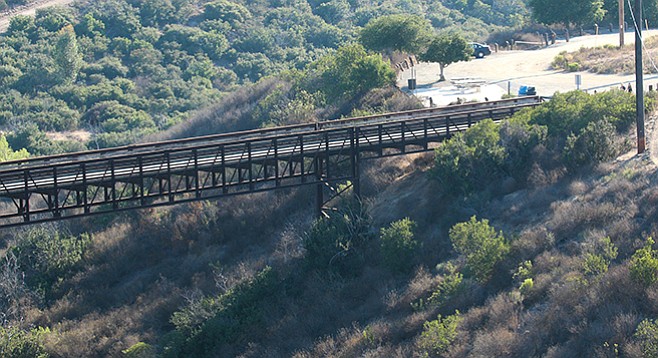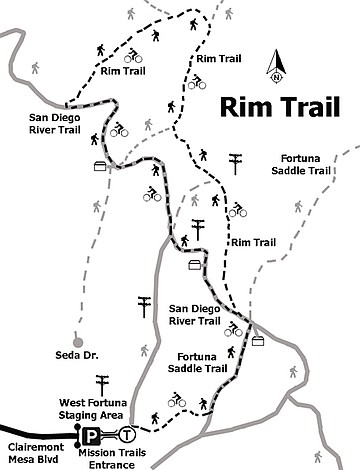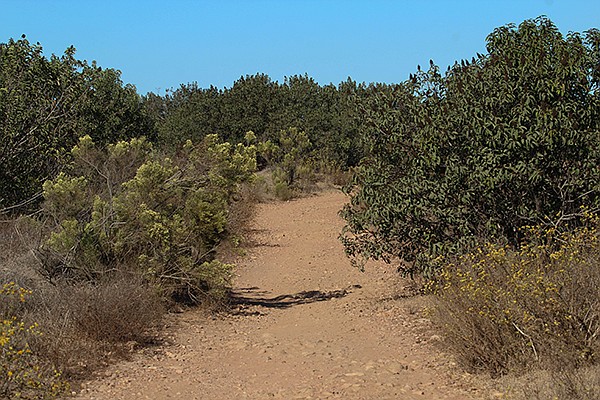 Facebook
Facebook
 X
X
 Instagram
Instagram
 TikTok
TikTok
 Youtube
Youtube

Mission Trails Regional Park (MTRP) is one of San Diego’s many treasures. It is one of the nation’s largest natural urban parks — one with a long history of use from Native Americans and Spanish missionaries to ranching and mining. Currently, the park has over 5800 acres and approximately 40 miles of trails. Of these trails, one that is a favorite with runners and mountain bikers is the Rim Trail, which offers panoramic views of the surrounding canyons and San Diego.
The Rim Trail starts at the West Fortuna staging area at the end of Clairemont Mesa Blvd. Starting from the parking lot, cross the bridge and head northeast to the mesa. Along this section, the trail is steep with a gain of about 300 feet in elevation, but once on top of the mesa it levels out. The main hazards to watch out for along the trail are rattlesnakes, mountain bikers, and the lack of shade. Ensure that you bring plenty of water and a good shade hat, because in the summer it is blazing-hot with no shade along the trail. As you hike around the rim loop, chamise, black sage, California sagebrush, and dozens of other chaparral plants will guide your way.

The best time of the year to hike the Rim Trail is spring. The weather is cooler and the seasonal rains from our Mediterranean climate will begin to renew the life within the chaparral — wildflowers will be blooming and shrubs will green up, bringing a richness of color and fragrances to the mesa. The rain will also reveal the Rim Trail’s special attraction — vernal pools.

As the rains begin, seasonal pools known as vernal pools begin filling. These pools are shallow basins that form due to the unique geology of the area. The pools vary in depth and size. Most are less than a foot deep and can cover an area no bigger than a puddle to that of a large car. Why do the pools form? Geology is the short answer. The hard volcanic rock found within the park along with thick layers of clay and silt creates the perfect conditions to retain the seasonal rain. However, the silt holds more than just water — there is something magical waiting patiently for the rain.
Almost overnight, the vernal pools spring to life. Eggs that have stayed dormant throughout the drought in what is known as “aestivation” (think of it as a type of drought hibernation) react to the rain and spawn into fairy shrimp — a species endemic to Southern California. Along with the shrimp, the spadefoot toad, which some scientists believe can sense the rain as it falls, hatches. Historically, there may have been hundreds of these microcosms scattered throughout the region. However, today there is only a handful of vernal pools found around the county due to habitat loss from encroachment of development.
Where can you find these puddle treasures? The best area to find them is along the top of the mesa. Follow the main trail northeast. The trail will make a large loop along the mesa and eventually head back to the trailhead. To find the pools, take the side trails that cut across the center of the loop. Look for sections of wooden fencing that have been erected along the pool edges making them more visible and that add protection for this endangered habitat.
Note: Bicycles only allowed on the main trail — not the side trails.

Distance from downtown San Diego: approximately 15 miles. Allow 20 minutes driving time. Take I-15 north to Tierrasanta Blvd. then turn east and continue to Santo Rd. At Santo Rd., turn north and drive until Clairemont Mesa Blvd. Turn east on Clairemont Blvd., continue to the end of the street, and park in a large gravel parking lot that serves as the trailhead.
Hiking length: 4.5-mile loop.
Difficulty: Moderate with elevation of +/- 300ft. The trail has no shade and is open all year to mountain biking, trail running, and hiking. Dogs are allowed on leashes. There are no facilities at this trailhead.


Mission Trails Regional Park (MTRP) is one of San Diego’s many treasures. It is one of the nation’s largest natural urban parks — one with a long history of use from Native Americans and Spanish missionaries to ranching and mining. Currently, the park has over 5800 acres and approximately 40 miles of trails. Of these trails, one that is a favorite with runners and mountain bikers is the Rim Trail, which offers panoramic views of the surrounding canyons and San Diego.
The Rim Trail starts at the West Fortuna staging area at the end of Clairemont Mesa Blvd. Starting from the parking lot, cross the bridge and head northeast to the mesa. Along this section, the trail is steep with a gain of about 300 feet in elevation, but once on top of the mesa it levels out. The main hazards to watch out for along the trail are rattlesnakes, mountain bikers, and the lack of shade. Ensure that you bring plenty of water and a good shade hat, because in the summer it is blazing-hot with no shade along the trail. As you hike around the rim loop, chamise, black sage, California sagebrush, and dozens of other chaparral plants will guide your way.

The best time of the year to hike the Rim Trail is spring. The weather is cooler and the seasonal rains from our Mediterranean climate will begin to renew the life within the chaparral — wildflowers will be blooming and shrubs will green up, bringing a richness of color and fragrances to the mesa. The rain will also reveal the Rim Trail’s special attraction — vernal pools.

As the rains begin, seasonal pools known as vernal pools begin filling. These pools are shallow basins that form due to the unique geology of the area. The pools vary in depth and size. Most are less than a foot deep and can cover an area no bigger than a puddle to that of a large car. Why do the pools form? Geology is the short answer. The hard volcanic rock found within the park along with thick layers of clay and silt creates the perfect conditions to retain the seasonal rain. However, the silt holds more than just water — there is something magical waiting patiently for the rain.
Almost overnight, the vernal pools spring to life. Eggs that have stayed dormant throughout the drought in what is known as “aestivation” (think of it as a type of drought hibernation) react to the rain and spawn into fairy shrimp — a species endemic to Southern California. Along with the shrimp, the spadefoot toad, which some scientists believe can sense the rain as it falls, hatches. Historically, there may have been hundreds of these microcosms scattered throughout the region. However, today there is only a handful of vernal pools found around the county due to habitat loss from encroachment of development.
Where can you find these puddle treasures? The best area to find them is along the top of the mesa. Follow the main trail northeast. The trail will make a large loop along the mesa and eventually head back to the trailhead. To find the pools, take the side trails that cut across the center of the loop. Look for sections of wooden fencing that have been erected along the pool edges making them more visible and that add protection for this endangered habitat.
Note: Bicycles only allowed on the main trail — not the side trails.

Distance from downtown San Diego: approximately 15 miles. Allow 20 minutes driving time. Take I-15 north to Tierrasanta Blvd. then turn east and continue to Santo Rd. At Santo Rd., turn north and drive until Clairemont Mesa Blvd. Turn east on Clairemont Blvd., continue to the end of the street, and park in a large gravel parking lot that serves as the trailhead.
Hiking length: 4.5-mile loop.
Difficulty: Moderate with elevation of +/- 300ft. The trail has no shade and is open all year to mountain biking, trail running, and hiking. Dogs are allowed on leashes. There are no facilities at this trailhead.
Comments